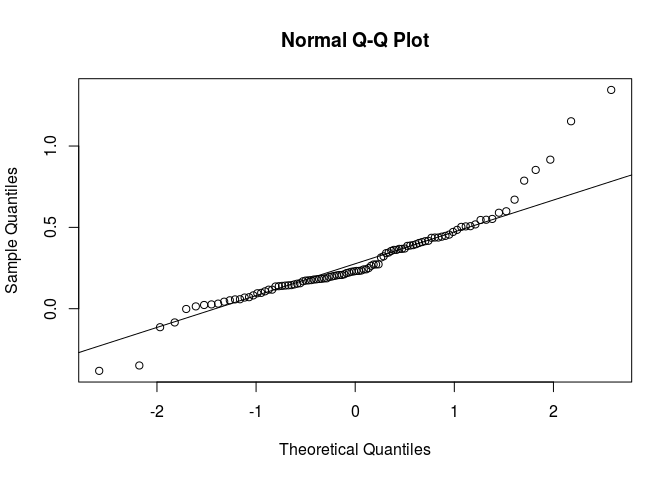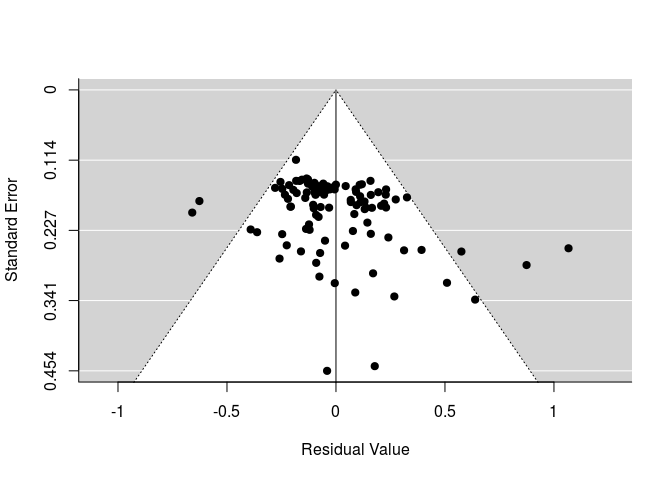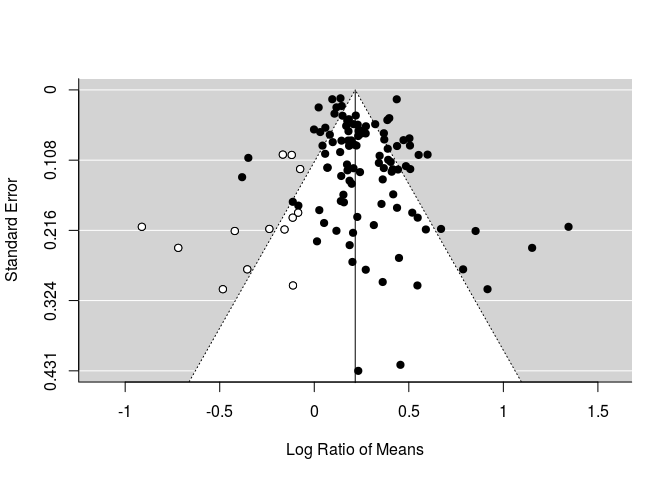Assumptions and biases
Assumptions and biases
Getting started
We’ll continue using the same data and model from previous days.
Load packages
require(gdata)
require(metafor)
require(dplyr)
Download data (Curtis et al. 1999)
curtis<-read.xls("http://www.nceas.ucsb.edu/meta/Curtis/Curtis_CO2_database.xls",as.is=TRUE,verbose=FALSE,sheet=1)
curtis_ES<-escalc(measure='ROM', m2i=X_AMB , sd2i=SD_AMB, n2i=N_AMB, m1i=X_ELEV, sd1i=SD_ELEV, n1i=N_ELEV, vtype='LS',var.names=c("LRR","LRR_var"),data=curtis)
## Warning in log(m1i/m2i): NaNs produced
#summary(as.factor(curtis_ES$PARAM))
curtis_WT<-filter(curtis_ES, PARAM=="TOTWT") # let's use whole plant weight because it has the largest number of observations
curtis_WT$GEN_SPP<-paste(curtis_WT$GENUS,curtis_WT$SPECIES,sep="_")
##
## Multivariate Meta-Analysis Model (k = 102; method: REML)
##
## logLik Deviance AIC BIC AICc
## -20.8378 41.6755 53.6755 69.2463 54.5886
##
## Variance Components:
##
## estim sqrt nlvls fixed factor
## sigma^2.1 0.0104 0.1019 29 no PAP_NO
## sigma^2.2 0.0093 0.0965 8 no XTRT
## sigma^2.3 0.0042 0.0649 37 no GEN_SPP
##
## Test for Residual Heterogeneity:
## QE(df = 99) = 719.5615, p-val < .0001
##
## Test of Moderators (coefficient(s) 2:3):
## QM(df = 2) = 0.0914, p-val = 0.9553
##
## Model Results:
##
## estimate se zval pval ci.lb ci.ub
## intrcpt 0.2778 0.0501 5.5423 <.0001 0.1796 0.3760 ***
## DIV2GYMNO -0.0044 0.0560 -0.0788 0.9372 -0.1142 0.1054
## DIV2N2FIX 0.0481 0.1687 0.2852 0.7755 -0.2826 0.3788
##
## ---
## Signif. codes: 0 '***' 0.001 '**' 0.01 '*' 0.05 '.' 0.1 ' ' 1
Assess model assumptions: homogeneity of variance and normality
Profile likelihood plots
These plots let us know if model parameters are ‘identifiable’. If they are identifiable, they peak at their estimates. If they are not, they may be flat which indicates that the model does not converge or is overparameterized. This is a fancy way of sayin that model estimates will be more reliable with a simpler random effects structure.
## Profiling sigma2 = 1
##
|
| | 0%
|
|=== | 5%
|
|====== | 10%
|
|========== | 15%
|
|============= | 20%
|
|================ | 25%
|
|==================== | 30%
|
|======================= | 35%
|
|========================== | 40%
|
|============================= | 45%
|
|================================ | 50%
|
|==================================== | 55%
|
|======================================= | 60%
|
|========================================== | 65%
|
|============================================== | 70%
|
|================================================= | 75%
|
|==================================================== | 80%
|
|======================================================= | 85%
|
|========================================================== | 90%
|
|============================================================== | 95%
|
|=================================================================| 100%

## Profiling sigma2 = 2
##
|
| | 0%
|
|=== | 5%
|
|====== | 10%
|
|========== | 15%
|
|============= | 20%
|
|================ | 25%
|
|==================== | 30%
|
|======================= | 35%
|
|========================== | 40%
|
|============================= | 45%
|
|================================ | 50%
|
|==================================== | 55%
|
|======================================= | 60%
|
|========================================== | 65%
|
|============================================== | 70%
|
|================================================= | 75%
|
|==================================================== | 80%
|
|======================================================= | 85%
|
|========================================================== | 90%
|
|============================================================== | 95%
|
|=================================================================| 100%

## Profiling sigma2 = 3
##
|
| | 0%
|
|=== | 5%
|
|====== | 10%
|
|========== | 15%
|
|============= | 20%
|
|================ | 25%
|
|==================== | 30%
|
|======================= | 35%
|
|========================== | 40%
|
|============================= | 45%
|
|================================ | 50%
|
|==================================== | 55%
|
|======================================= | 60%
|
|========================================== | 65%
|
|============================================== | 70%
|
|================================================= | 75%
|
|==================================================== | 80%
|
|======================================================= | 85%
|
|========================================================== | 90%
|
|============================================================== | 95%
|
|=================================================================| 100%

Quantile-Quantile plots
qqnorm(curtis_WT$LRR)
qqline(curtis_WT$LRR)

Model residuals
Residuals vs. fitted
plot(fitted(re_wt4), rstandard(re_wt4)$z)
abline(h =0)

Pearson model residuals
plot(residuals(re_wt4, type="pearson"))
abline(h =0)

Influential points or outliers
Cook’s distance
This plot helps you find outliers and influential points.
plot(cooks.distance(re_wt4))

Publication bias
There are two main ways of detecting publication bias: 1) by testing if effect sizes are unusually high (i.e. asymmetric) or 2) estimating the number of studies needed to change the signficance of a mean effect size.
Funnel plot
funnel(re_wt4)

Egger’s regression
Egger’s regression tests for funnel plot asymmetry. One can use a number of moderators; the most common are the inverse of sampling variance or standard errors.
```r
test.egger = rma.mv(LRR,LRR_var, mod = LRR_var, random=list(~1|PAP_NO, ~1|XTRT, ~1|GEN_SPP), data = curtis_WT)
summary(test.egger)
```
```
##
## Multivariate Meta-Analysis Model (k = 102; method: REML)
##
## logLik Deviance AIC BIC AICc
## -18.1427 36.2853 46.2853 59.3112 46.9236
##
## Variance Components:
##
## estim sqrt nlvls fixed factor
## sigma^2.1 0.0102 0.1009 29 no PAP_NO
## sigma^2.2 0.0074 0.0861 8 no XTRT
## sigma^2.3 0.0033 0.0579 37 no GEN_SPP
##
## Test for Residual Heterogeneity:
## QE(df = 100) = 740.2733, p-val < .0001
##
## Test of Moderators (coefficient(s) 2):
## QM(df = 1) = 4.0127, p-val = 0.0452
##
## Model Results:
##
## estimate se zval pval ci.lb ci.ub
## intrcpt 0.2534 0.0445 5.6963 <.0001 0.1662 0.3406 ***
## mods 1.9360 0.9665 2.0032 0.0452 0.0418 3.8303 *
##
## ---
## Signif. codes: 0 '***' 0.001 '**' 0.01 '*' 0.05 '.' 0.1 ' ' 1
```
Note that there is a function in metafor (‘regtest’) for more simple models.
Fail-safe number
How many studies (or observations) would be needed to make the mean effect size effectively zero?
Note that the ‘Rosenberg’ and ‘Rosenthal’ methods estimates weighted effect sizes, while the ‘Orwin’ method estimates unweighted effect sizes. This methodological difference explains the contrasting magnitudes of the estimated fail-safe numbers.
fsn(LRR, LRR_var, data=curtis_WT,type="Rosenberg")
##
## Fail-safe N Calculation Using the Rosenberg Approach
##
## Average Effect Size: 0.2088
## Observed Significance Level: <.0001
## Target Significance Level: 0.05
##
## Fail-safe N: 38924
fsn(LRR, LRR_var, data=curtis_WT,type="Rosenthal")
##
## Fail-safe N Calculation Using the Rosenthal Approach
##
## Observed Significance Level: <.0001
## Target Significance Level: 0.05
##
## Fail-safe N: 36162
fsn(LRR, LRR_var, data=curtis_WT,type="Orwin")
##
## Fail-safe N Calculation Using the Orwin Approach
##
## Average Effect Size: 0.2844
## Target Effect Size: 0.1422
##
## Fail-safe N: 102
Trim & fill
Trim & fill is a method to estimate the missing number of studies, possibly due to biases (publication or others) that omit or exclude the inclusion of extreme results. Doing so makes the funnel plot more symmetric.
Trim & fill is not currently implemented for ‘rma.mv’ objects, but can be done easily for either fixed or random effect models.
ree<-rma(LRR, LRR_var, data=curtis_WT)
taf <- trimfill(ree)
taf$k0 #number of studies to add
## [1] 13
taf$side #which side should they be added to?
## [1] "left"
funnel(taf)

Note that points in white are those added by the trim-and-fill analysis.